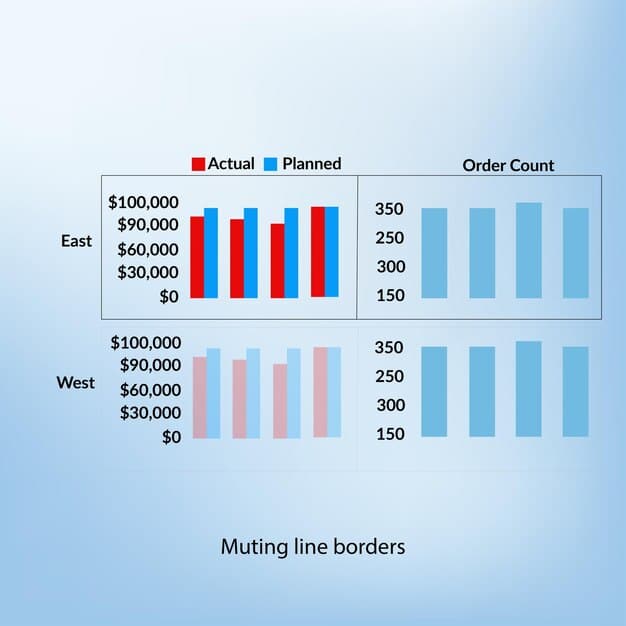Understanding Budget Variance: A Comprehensive Guide

Understanding budget variance is crucial for effective financial management, helping you identify and analyze discrepancies between your planned budget and actual expenditures, enabling informed adjustments to achieve financial goals.
Effective budgeting is a cornerstone of financial stability, but even the most meticulously crafted budget can deviate from reality. Understanding budget variance is essential for identifying these deviations, analyzing their causes, and making informed adjustments to keep your finances on track.
What is Budget Variance?
Budget variance is the difference between your planned budget and your actual financial performance. It’s a key indicator of financial health and allows you to identify areas where your spending or revenue deviates from expectations.
By understanding the differences between projected figures and actual results, you can proactively address discrepancies and refine your financial strategy.
Types of Budget Variance
Budget variances can be either favorable or unfavorable, depending on whether the actual result is better or worse than budgeted.
- Favorable Variance: Occurs when actual revenue is higher than budgeted or actual expenses are lower than budgeted. This is generally a positive outcome.
- Unfavorable Variance: Occurs when actual revenue is lower than budgeted or actual expenses are higher than budgeted. This indicates potential problems that require attention.
Analyzing both favorable and unfavorable variances is crucial for a comprehensive understanding of your financial situation. Favorable variances might reveal opportunities for further optimization, while unfavorable variances highlight areas needing immediate correction.

Why is Budget Variance Analysis Important?
Budget variance analysis is a critical tool for effective financial management. It provides insights into performance, identifies potential problems, and enables data-driven decision-making.
Without analyzing budget variances, you risk losing control of your finances and missing opportunities to improve efficiency and profitability.
Identifying Financial Problems
Budget variance analysis helps identify potential financial problems before they escalate. Unfavorable variances in expense categories can signal overspending, inefficiencies, or unexpected costs.
By proactively identifying these issues, you can take corrective action to prevent them from impacting your overall financial performance.
Improving Financial Forecasting
Analyzing budget variances allows you to refine your financial forecasting process. By understanding why your actual results differed from your budget, you can improve the accuracy of future budgets.
- Review historical data to identify recurring variance patterns.
- Adjust your budgeting assumptions based on past performance.
- Incorporate external factors, such as market trends and economic conditions, into your forecasts.
Improving your forecasting accuracy enables you to make more realistic financial plans and achieve your financial goals more effectively.
In summary, budget variance analysis is an indispensable tool for gaining financial control, proactively addressing issues, and refining your financial planning processes. This regular practice ensures informed decision-making and promotes long-term financial health.
Steps to Analyze Budget Variance
Analyzing budget variance involves a systematic process of identifying deviations, determining their causes, and implementing corrective actions. Here’s a step-by-step guide to effectively analyze budget variance.
Start by comparing your budgeted figures with your actual results. Identify the specific areas where significant variances occur.
Calculate the Variance
Determine the magnitude of the variance by calculating the difference between the budgeted amount and the actual amount. This can be expressed as a dollar amount or as a percentage.
The formula for calculating variance is simple: `Variance = Actual Amount – Budgeted Amount`.
Investigate the Causes
Once you’ve identified the variances, investigate the underlying causes. This may involve reviewing invoices, interviewing employees, or conducting market research.
- Material Costs: Fluctuations in raw material prices, changes in supplier contracts, or unexpected waste.
- Labor Costs: Overtime, increased headcount, changes in wage rates, or training expenses.
- Sales Volume: Changes in demand, marketing effectiveness, or competitive landscape.
- Market Conditions: Economic downturn, regulatory changes, or shifts in consumer preferences.
In essence, the analysis of budget variance provides crucial insights that drive informed decisions and promote continuous financial improvement. By embracing this proactive approach, businesses can adeptly steer their financial course, even in the face of unforeseen economic headwinds.

Common Causes of Budget Variance
Understanding the common causes of budget variance is crucial for effective analysis and corrective action. Variances can arise from a variety of internal and external factors.
Identifying these causes allows you to address the root issues and prevent similar variances from occurring in the future.
Unexpected Expenses
Unexpected expenses are a common cause of unfavorable budget variances. These can include emergency repairs, legal fees, or unexpected tax liabilities.
Creating a contingency fund in your budget can help mitigate the impact of unexpected expenses.
Inaccurate Forecasting
Inaccurate forecasting can lead to significant budget variances. Overly optimistic or pessimistic assumptions can result in unrealistic budgets.
Regularly review and update your forecasting methods based on historical data and market trends.
External Factors
External factors, such as changes in market conditions, economic downturns, or regulatory changes, can significantly impact your budget.
- Economic Downturn: Reduced consumer spending, decreased demand for products or services.
- Regulatory Changes: New taxes, compliance requirements, or environmental regulations.
- Market Conditions: Increased competition, changes in consumer preferences, or technological disruptions.
Understanding these common causes of budget variances enables businesses to proactively address potential financial challenges and refine their strategies for future budgeting cycles. This knowledge empowers financial managers to make informed decisions and maintain financial stability.
How to Adjust Your Spending Based on Variance Analysis
Once you’ve analyzed your budget variances and identified their causes, it’s time to adjust your spending to bring your finances back on track. This may involve cutting expenses, increasing revenue, or reallocating resources.
Effective spending adjustments require a careful assessment of your financial priorities and a willingness to make difficult decisions.
Cut Non-Essential Expenses
Identify non-essential expenses that can be reduced or eliminated. This may include discretionary spending, subscriptions, or travel expenses.
Prioritize essential expenses that are critical to your core business operations.
Increase Revenue
Explore opportunities to increase revenue, such as launching new products or services, expanding into new markets, or improving marketing efforts.
Evaluate the potential return on investment for each revenue-generating initiative.
Reallocate Resources
Consider reallocating resources from underperforming areas to more profitable ones. This may involve shifting personnel, equipment, or marketing budgets.
- Evaluate performance metrics for each department or product line.
- Identify areas where resources are being underutilized.
- Reallocate resources to areas with higher growth potential.
Achieving financial stability often necessitates a blend of strategic cost management and innovative revenue enhancement initiatives. Businesses that proactively manage their spending and creatively seek new income streams are better positioned to navigate economic fluctuations and achieve sustained financial success.
Tips for Effective Budget Variance Management
Effective budget variance management requires a proactive and ongoing effort. Here are some tips to help you manage budget variances more effectively.
Regularly review your budget and actual results to identify variances early on.
Establish Variance Thresholds
Set variance thresholds to trigger investigations. This will help you focus your attention on the most significant variances.
For example, you might set a threshold of 5% or $1,000 for expense categories.
Use Budgeting Software
Utilize budgeting software to streamline the budgeting and variance analysis process. Budgeting software can automate the calculation of variances and provide real-time insights into your financial performance.
Explore different budgeting software options to find one that meets your specific needs and budget.
Communicate Regularly
Communicate regularly with your team about budget variances and financial performance. This will help everyone understand the importance of adhering to the budget and working towards financial goals.
Foster a culture of financial accountability and transparency within your organization.
By integrating these strategies into your routine financial management practices, you fortify your ability to adapt swiftly to unforeseen challenges and seize emerging opportunities. With consistent and transparent variance analysis, you’ll be better equipped to chart a course toward ongoing financial prosperity and stability.
| Key Point | Brief Description |
|---|---|
| 🔍 Identifying Variances | Compare budgeted vs. actual results to spot deviations. |
| 💡 Analyzing Causes | Investigate the underlying reasons for significant variances. |
| 📉 Adjusting Spending | Cut non-essential expenses and reallocate resources. |
| 🗓️ Regular Monitoring | Continuously review and refine your budgeting process. |
Frequently Asked Questions (FAQ)
A favorable budget variance occurs when actual revenue exceeds the budgeted revenue or when actual expenses are less than the budgeted expenses, indicating positive financial performance.
Budget variance analysis should be conducted regularly, ideally on a monthly or quarterly basis, to identify and address any deviations from your budget in a timely manner.
Common tools include spreadsheets (like Excel), budgeting software, and accounting software. These tools help track, compare, and analyze budgeted vs. actual financial data efficiently.
External factors like economic downturns, regulatory changes, and market shifts can significantly affect your budget by altering revenue streams and inflating unexpected expenses, causing budget variances.
Consistently unfavorable variances require a thorough review of your budgeting process, expense control measures, and revenue projections to identify and address root causes proactively.
Conclusion
Understanding and effectively managing budget variances is critical for maintaining financial stability and achieving your long-term financial goals. By implementing the strategies outlined in this guide, you can proactively identify, analyze, and address variances, ensuring that your finances remain on track.





